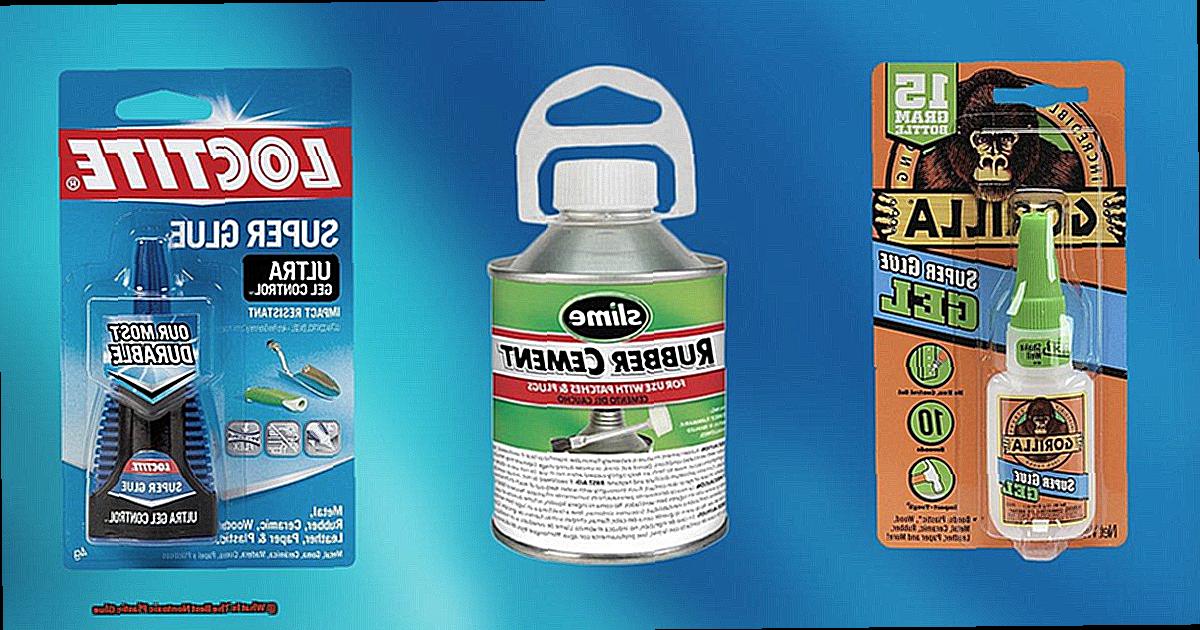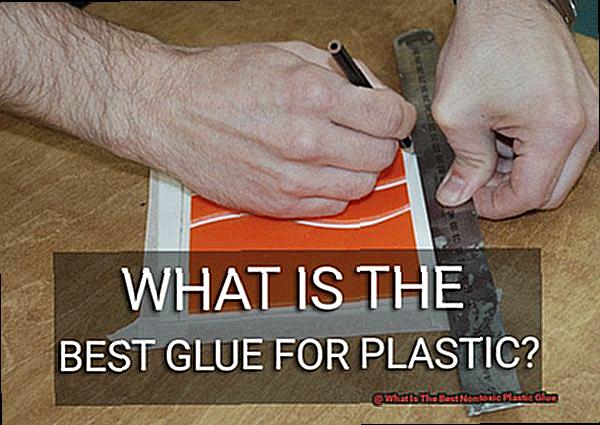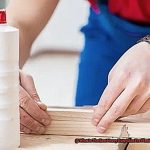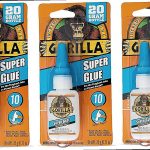Are you tired of sacrificing your health and the environment for the sake of sticking things together? Well, fear not. We’ve done the legwork to find the perfect solution for all your plastic bonding needs. Get ready to meet the best nontoxic plastic glue that will revolutionize your crafting experience.
Gone are the days of gag-inducing odors and harmful chemicals lurking in your adhesive. Thanks to some serious innovation, we now have a whole range of eco-friendly options at our fingertips. But with so many products claiming to be non-toxic, how do we separate the real deal from the imposters?
That’s where we come in. After diving headfirst into research, testing out countless glues, and consulting with fellow crafters and pros alike, we’ve narrowed it down to one champion – the ultimate nontoxic plastic glue that will blow your mind.
Whether you’re working with PVC, acrylic, polystyrene, or any other type of plastic under the sun, this glue is here to save the day. Not only does it bond like a boss, but it also puts your health and the planet first. Because creating beautiful things shouldn’t come at a cost – neither to ourselves nor Mother Earth.
So get ready to dive into a world where your imagination can run wild without worrying about toxic fumes or environmental harm. It’s time to unleash your creativity with the best nontoxic plastic glue on the market. Stick around (pun intended), because we’re about to embark on an adhesive adventure like no other.
Benefits of Using Nontoxic Plastic Glue
Contents
- 1 Benefits of Using Nontoxic Plastic Glue
- 2 Factors to Consider When Choosing the Best Nontoxic Plastic Glue
- 3 Types of Nontoxic Plastic Glues
- 4 Recommended Brands of Nontoxic Plastic Glues
- 5 Application Tips for Using Nontoxic Plastic Glue
- 6 Safety Precautions When Using Nontoxic Plastic Glue
- 7 Common Mistakes to Avoid When Applying Nontoxic Plastic Glue
- 8 Alternatives to Nontoxic Plastic Glues
- 9 Conclusion
When it comes to adhesive bonding, nontoxic plastic glue offers numerous benefits that make it a superior choice compared to traditional glues. Not only does it provide a strong and durable bond, but it also prioritizes the health and safety of users and the environment. In this article, we will explore the advantages of using nontoxic plastic glue, including its safety for children, versatility, eco-friendliness, allergen-free nature, water resistance, and more.
Safety for Children:
- Eliminates harmful chemicals like formaldehyde, toluene, and acetone found in traditional glues.
- Reduces the risk of accidental ingestion or inhalation for young users during arts and crafts projects.
- Provides peace of mind for parents while allowing children to explore their creativity.
Versatility:
- Bonds various materials such as plastics, acrylics, and non-porous surfaces effectively.
- Ideal for repairing broken plastic toys or creating craft projects.
- Dries clear, ensuring a clean and transparent finish for aesthetically pleasing results.
Eco-Friendly:
- Made from natural ingredients or water-based formulas.
- Biodegradable and less harmful to the environment.
- Reduces air pollution by eliminating volatile organic compounds (VOCs) present in traditional glues.
- Prevents harm to aquatic ecosystems when disposed of properly.
Allergen-Free:
- Does not contain allergenic compounds that can cause skin irritation or respiratory issues.
- Suitable for individuals with allergies or sensitivities.
- Provides a safe option for adhesive bonding without potential allergic reactions.
Water Resistance and Waterproof:
- Offers water-resistant or waterproof properties once fully cured.
- Ideal for outdoor projects or items that may come into contact with moisture.
- Provides reliability and durability for various applications, such as repairing plastic garden ornaments or creating a waterproof seal on plastic containers.
Factors to Consider When Choosing the Best Nontoxic Plastic Glue
When choosing the best nontoxic plastic glue, there are several factors to consider. These factors will not only ensure that you have a strong bond but also prioritize your safety and the environment. Here are the key factors to keep in mind:
- Safety comes first: Look for glues that are labeled as non-toxic and free from harmful substances such as formaldehyde, phthalates, and lead. Additionally, opt for glues with low VOC levels, as these can also be harmful to your health.
- Bonding strength matters: Different plastic glues have varying bonding strengths, so choose a glue that is suitable for the specific type of plastic you are working with. Consider the intended use of the glued object and select a glue that provides the desired level of bonding strength.
- Drying time can be a game-changer: If you are working on a time-sensitive project, opt for a glue with a quick drying time. However, keep in mind that faster drying glues may have a shorter open time, so work quickly before the glue sets. If time is not a concern, choose a glue with a longer drying time.
- Application method should align with your project: Consider the application method of the glue and how it aligns with your project requirements. Some glues come in squeeze bottles with precision tips, ideal for small intricate projects. Others may come in spray form, convenient for larger surfaces or hard-to-reach areas.
- Compatibility is key: Not all glues are compatible with all types of plastics. Check the compatibility of the glue with the specific type of plastic you are working with. Always read the product instructions or consult with the manufacturer to ensure that the glue is compatible with your chosen plastic material.
- Flexibility for durability: Some projects require a glue that can withstand bending and flexing without losing its adhesive properties. Choose a glue that offers flexibility if your glued object will be subject to movement or stress.
- Ease of use matters: Look for glues with clear instructions and easy handling and application. Glues with built-in applicators or user-friendly designs can make the gluing process smoother and more efficient. Additionally, consider the cleanup process and whether the glue can be easily removed if needed.
Types of Nontoxic Plastic Glues
When it comes to bonding plastic materials, choosing the right adhesive is crucial. Fortunately, there is a wide range of nontoxic plastic glues available that provide safe and strong bonds without compromising your health or the environment. In this article, we will delve into the world of these glues and explore their various types and uses.
Water-Based Glue: The All-Purpose Solution
Water-based glues are a popular choice for bonding plastics due to their versatility and ease of use. These glues are safe for everyone and do not release harmful fumes or chemicals. With their clear drying formula, they create seamless bonds between different types of plastics. Moreover, water-based glues can also be used on materials like paper, fabric, and wood, making them ideal for craft projects or repairing plastic items.
Solvent-Free Glue: Gentle Yet Effective
For individuals with sensitivities or allergies, solvent-free glues offer a safe alternative. These adhesives do not contain any harsh chemicals or solvents, making them gentle on both you and the environment. Despite being nontoxic, solvent-free glues provide a secure bond between plastic surfaces without compromising on strength. They are perfect for various applications, from simple repairs to intricate art projects.
Specialized Formulations: Bonding Challenging Plastics

Certain plastics, such as polyethylene and polypropylene, possess low surface energy, making them challenging to bond. However, specialized nontoxic plastic glues have been formulated specifically for these difficult-to-bond plastics. These glues contain additives that enhance adhesion and ensure a strong bond between polyethylene or polypropylene surfaces. With these specialized formulations, you can confidently tackle projects involving these notoriously tricky plastics.
UV-Curing Adhesives: Fast and Reliable
When speed and reliability are of the essence, UV-curing adhesives shine. These glues require exposure to ultraviolet light to cure and form a strong bond. Industries such as electronics assembly or medical device manufacturing often rely on UV-curing adhesives for their quick and reliable results. In addition to excellent adhesion on various types of plastics, UV-curing adhesives also offer resistance to moisture, heat, and chemicals, ensuring long-lasting bonds.
Epoxy-Based Glues: Versatile and Durable
Epoxy-based glues are renowned for their exceptional bond strength and versatility. Although they require mixing before application, fully cured epoxy glues are considered nontoxic. These glues provide a durable bond on different types of plastics, making them suitable for a wide range of applications. Whether you’re undertaking automotive repairs or creating plastic prototypes, epoxy-based glues offer reliable and long-lasting adhesion.
Recommended Brands of Nontoxic Plastic Glues
When it comes to choosing the right glue for your plastic projects, safety should be a top priority. Toxic glues not only harm the environment but also pose risks to your health. That’s why opting for nontoxic plastic glues is a smart choice.
Nontoxic plastic glues are formulated without harmful chemicals like volatile organic compounds (VOCs) and phthalates. They provide reliable bonding while ensuring that you can work on your projects worry-free.
There are several trusted brands in the market that offer nontoxic plastic glues. Let’s take a closer look at some of them:
- Elmer’s: With a long history of providing quality adhesives, Elmer’s is a well-known and highly regarded brand. Their nontoxic glues are widely available and AP certified by the Art and Creative Materials Institute (ACMI), ensuring their safety. Elmer’s offers various types of glues, including all-purpose glue, super glue, and epoxy glue.
- Aleene’s: With over 60 years in the adhesive industry, Aleene’s has earned a strong reputation for their reliable products. Their nontoxic glues are also AP certified and offer a range of options, including all-purpose glue and specialty glues for specific plastic materials.
- Beacon: Beacon is known for its high-quality adhesives that cater to different needs. Their nontoxic plastic glues are AP certified and offer excellent bonding capabilities for various plastic surfaces. They provide options like all-purpose glue and specialized formulations for different plastic types.
- Gorilla Glue: Synonymous with strong bonds and durability, Gorilla Glue also offers nontoxic options. Their glues are AP certified and provide reliable bonding for plastic materials. They have a range of glues, including all-purpose glue and epoxy glue.
When using nontoxic plastic glues, proper application techniques and curing times are important. Ensure the surface is clean and dry before applying the glue, and allow sufficient time for the adhesive to cure for maximum bond strength.
Application Tips for Using Nontoxic Plastic Glue
In this article, we will explore the importance of using nontoxic plastic glue and provide step-by-step instructions to ensure successful bonding. Get ready to unleash your creativity while keeping your health and the environment in mind.
Why Choose Nontoxic Plastic Glue?
When it comes to our health and the environment, nontoxic plastic glue is the way to go. Traditional glues may contain harmful chemicals that can be dangerous when inhaled or absorbed through the skin. Nontoxic glues are designed to be safe for use, making them ideal for crafting with children or in enclosed spaces. With nontoxic plastic glue, you can bond your projects with peace of mind.
Surface Preparation:
Before applying nontoxic plastic glue, it’s essential to prepare the surfaces properly. Clean both surfaces thoroughly to remove any dirt, debris, or oils that may hinder the adhesive strength. A gentle wipe with a clean cloth and some mild soap should do the trick. Ensure the surfaces are completely dry before moving on to the next step. Remember, a clean surface is key to achieving a strong bond.
Choosing the Right Glue:
Not all plastics are created equal, and different types of plastics require specific adhesives. When selecting your nontoxic plastic glue, check the label for compatibility with the type of plastic you’re working with. Common plastics include polyethylene, polypropylene, PVC, and more. Using a glue that is specifically formulated for the type of plastic you are bonding will ensure optimal results.
Applying the Glue:
Now it’s time to apply the nontoxic plastic glue. Apply a thin layer of glue evenly on both surfaces that you want to bond. Remember, less is more. Using too much glue can result in a weak bond. Allow the glue to dry for a few minutes until it becomes tacky. This step is crucial as it ensures proper adhesion when joining the surfaces together. Take your time and let the glue do its magic.
Clamping for Strength:
To achieve a strong bond, apply pressure or use clamps to hold the glued pieces together until the adhesive fully cures. This can take anywhere from a few hours to 24 hours, depending on the glue you’re using. Be sure to follow the manufacturer’s instructions regarding drying and curing times. Proper clamping enhances the bond and ensures that your project will withstand the test of time.
Safety Precautions When Using Nontoxic Plastic Glue
Crafting with nontoxic plastic glue can be a fun and fulfilling experience. However, it is important to prioritize safety to avoid any potential risks. In this article, we will discuss the necessary precautions to take while using nontoxic plastic glue and how to protect yourself from any potential hazards.
Read and Follow Instructions:
To ensure safety, always start by carefully reading and following the instructions provided by the manufacturer. These instructions often contain specific safety guidelines that are crucial to follow for a safe crafting experience.
Work in a Well-Ventilated Area:
When using nontoxic plastic glue, it is essential to work in a well-ventilated area. This means ensuring proper air circulation to minimize exposure to any fumes that may be released during the gluing process. Open windows or use fans to improve ventilation.
Wear Protective Gear:
Protective gear is a must when working with nontoxic plastic glue. Wear gloves and safety glasses, especially when working with larger quantities of glue or using it for an extended period of time. Gloves will protect your skin from potential irritation, while safety glasses will shield your eyes from accidental splashes.
Handle Accidental Skin Contact:
In case of accidental skin contact with the glue, wash the affected area thoroughly with soap and water. It is crucial to act promptly to prevent any adverse reactions. If irritation persists or other adverse symptoms occur, seek medical attention immediately.
Eye Protection:
If the glue comes into contact with your eyes, rinse them immediately with clean water for at least 15 minutes. This will help flush out any residue and reduce the risk of potential eye damage. If discomfort or vision problems persist, seek medical attention promptly.
Keep Out of Reach of Children and Pets:
To prevent ingestion, always keep nontoxic plastic glue out of reach of children and pets. Accidental ingestion can be harmful, so it is important to store the glue in a secure location. If ingestion occurs, seek immediate medical attention and provide the medical professional with the product label or any relevant information.
Proper Storage:
Proper storage is essential to maintain the effectiveness of nontoxic plastic glue and prevent potential hazards. Store it in a cool, dry place away from direct sunlight or heat sources. This will help preserve its adhesive properties and prevent the glue from deteriorating.
Disposal:
When disposing of empty containers or unused glue, follow proper disposal methods as outlined by local waste management regulations. This includes recycling or disposing of the product responsibly to ensure minimal environmental impact.
Common Mistakes to Avoid When Applying Nontoxic Plastic Glue
Crafting with nontoxic plastic glue is a safe and enjoyable way to bring your creative visions to life. However, to ensure successful and long-lasting results, it’s important to avoid some common mistakes that can compromise the strength and durability of your bonds. In this article, we will discuss key points to help you achieve optimal outcomes when using nontoxic plastic glue.
Properly prepare the surface:
Neglecting to clean the plastic surface before applying the glue is a recipe for weak bonds. Dirt, grease, or residue can create a barrier that prevents the adhesive from adhering effectively. Take the time to thoroughly clean and dry the plastic, ensuring a clean canvas for your glue to work its magic.
Use the right amount of glue:
While it may be tempting to apply a liberal amount of glue in hopes of achieving a stronger bond, this can actually have the opposite effect. Excessive glue can create gaps between the surfaces, compromising the integrity of the bond. Instead, opt for a thin, even layer of glue to ensure optimal adhesion.
Apply the glue in the correct order:
When working on projects that involve multiple pieces of plastic, it’s crucial to apply the glue in the correct order. Start by gluing smaller pieces together before attaching them to larger ones. This method ensures that all parts are securely bonded, minimizing misalignment and unevenness in your final creation.
Allow sufficient drying and curing time:
Patience is key when working with nontoxic plastic glues. Rushing the drying and curing process by handling or moving glued plastic before it has fully cured can result in weak bonds or complete failure. Respect the recommended drying times provided by the manufacturer and give your project ample time to reach its maximum strength.
Ensure compatibility between glue and plastic:
Not all nontoxic plastic glues are created equal, and each type may have specific compatibility requirements. Always check the product label or instructions to ensure that the glue you are using is suitable for the specific type of plastic being used. Using an incompatible glue can lead to weak or non-existent bonding.
Apply sufficient pressure during bonding:
Applying adequate pressure during the bonding process is crucial for creating a strong and durable bond. Utilize clamps or weights to hold the glued parts together while the glue cures. This ensures that the adhesive makes full contact with both surfaces, maximizing the strength of the bond. Insufficient pressure can result in weaker bonds that may easily come apart.
Alternatives to Nontoxic Plastic Glues
In this article, we will explore exciting alternatives to nontoxic plastic glues that not only provide a strong bond but also prioritize your health and the planet.
Water-Based Adhesive:
One fantastic alternative to consider is water-based adhesive. Crafted from natural ingredients like starch or cellulose, these glues are not only safe but also biodegradable. They offer a robust bond without the need for toxic chemicals. Versatile and ideal for most craft projects, water-based adhesives can be used on various types of plastics, making them a top choice for eco-friendly creatives.
Natural Rubber Adhesive:
Derived from the sap of rubber trees, natural rubber adhesive is another excellent option. This adhesive contains no harmful substances and is renowned for its flexibility and durability. It provides a reliable bond for plastics, making it a popular choice in industries that require flexibility.
Bio-Based Adhesives:
For those seeking the ultimate sustainable option, bio-based adhesives are worth exploring. These adhesives are crafted from renewable resources such as plant-based materials or biopolymers. Offering a nontoxic and eco-friendly solution to bonding plastics, bio-based adhesives are favored by environmentally conscious individuals.
Safety Precautions:
While these alternatives are generally considered safer than traditional plastic glues, it is crucial to read labels and follow manufacturer instructions. Each adhesive may have specific usage guidelines and safety precautions to ensure proper usage and minimize potential risks.
Conclusion
When it comes to finding the best nontoxic plastic glue, there are a few top contenders that stand out from the crowd. These glues not only provide a strong bond for your plastic projects, but they also prioritize safety and environmental friendliness.
One standout option is the E6000 Craft Adhesive. This glue is known for its versatility and ability to bond various materials, including plastic. It dries clear and flexible, making it perfect for both indoor and outdoor projects. Plus, it’s non-toxic and odorless, ensuring a safe working environment.
Another excellent choice is the Aleene’s Original Tacky Glue. This adhesive has been trusted by crafters for years due to its reliable hold and non-toxic formula. It works well on plastics and other surfaces, providing a strong bond without any harmful fumes or chemicals.
If you’re looking for an eco-friendly option, look no further than the Gorilla Wood Glue. While it may be marketed as a wood glue, it also works wonders on plastic materials. This glue is made with water-based ingredients and is free from harmful solvents, making it safe to use around children and pets.
Lastly, we have the Beacon Zip Dry Paper Glue. Although primarily designed for paper crafts, this glue also excels at bonding lightweight plastics. It dries quickly with a strong hold and remains flexible once cured. And of course, it’s non-toxic and acid-free.
In conclusion, when searching for the best nontoxic plastic glue, options like E6000 Craft Adhesive, Aleene’s Original Tacky Glue, Gorilla Wood Glue, and Beacon Zip Dry Paper Glue rise above the rest in terms of performance and safety.






